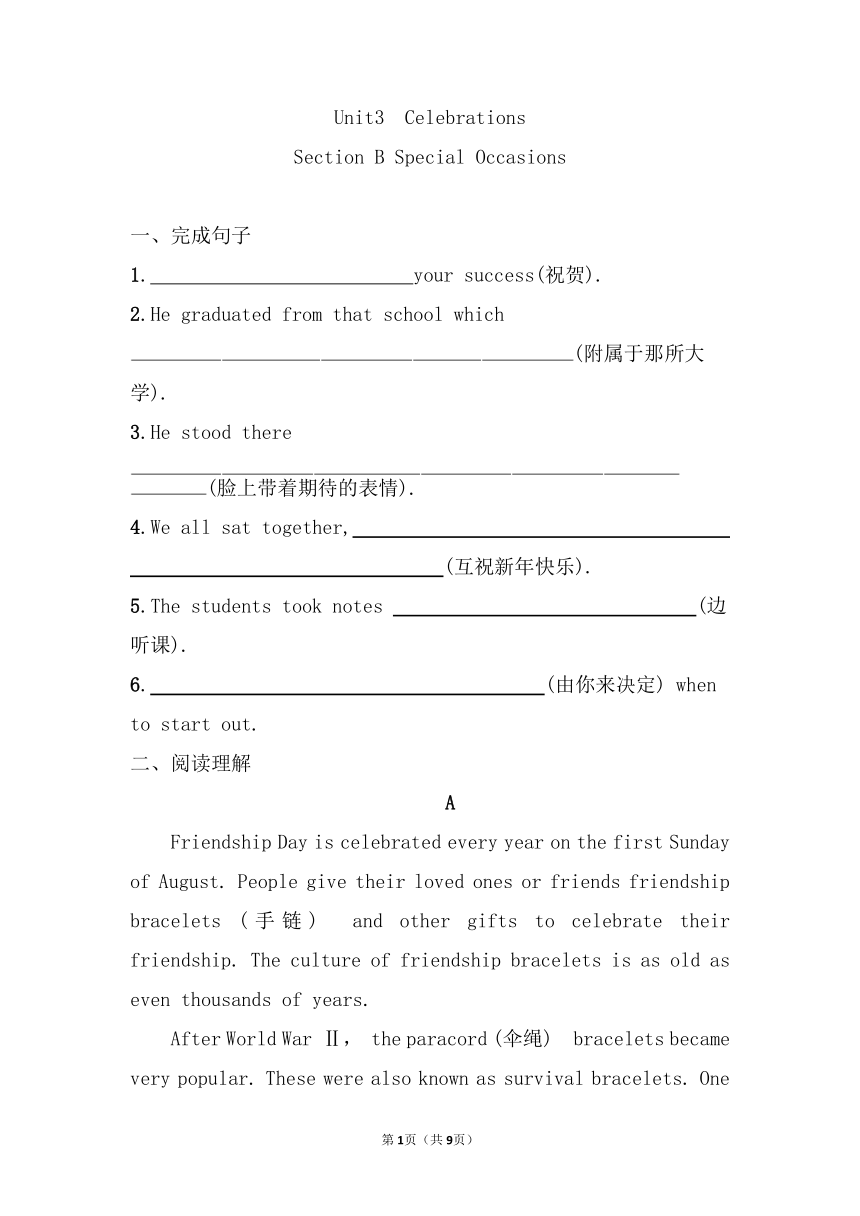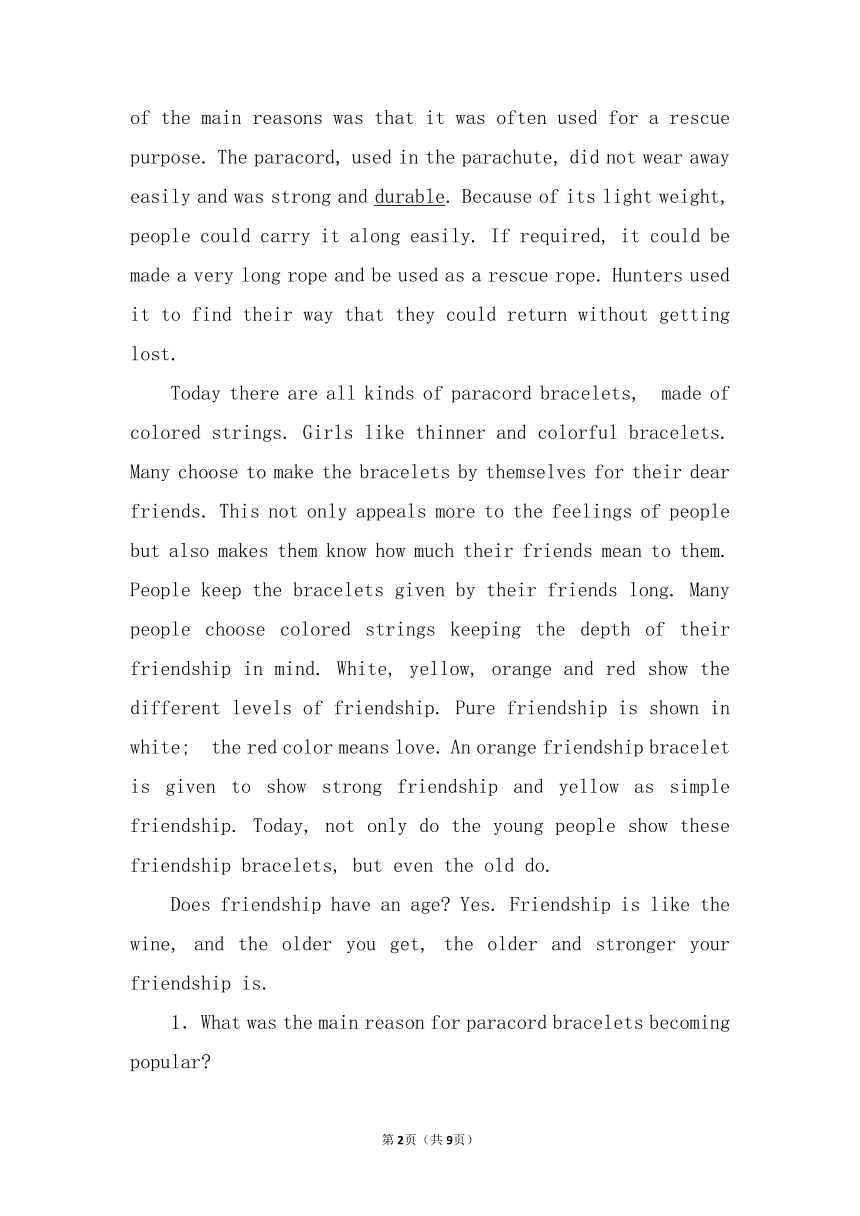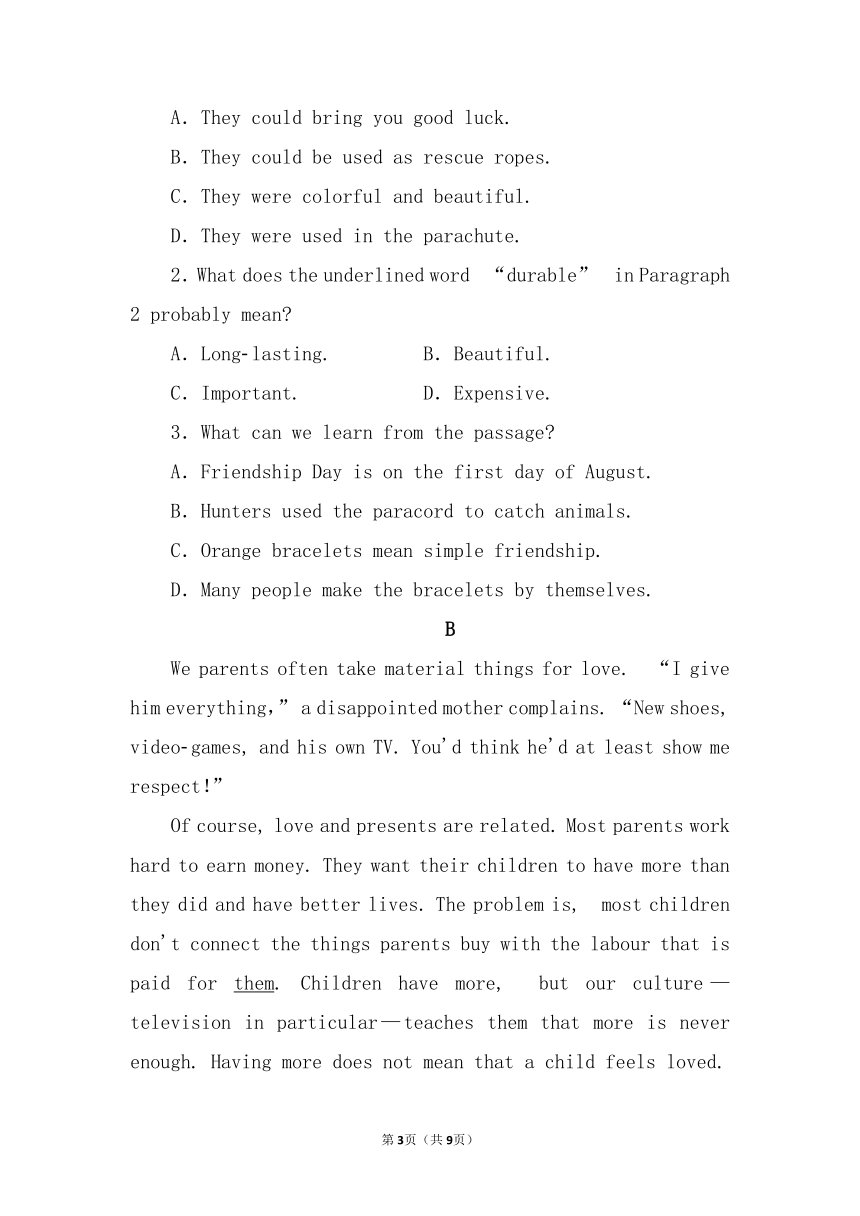北师大版(2019)必修第一册:Unit 3 Celebrations Special Occasions 同步一练(含答案)
文档属性
| 名称 | 北师大版(2019)必修第一册:Unit 3 Celebrations Special Occasions 同步一练(含答案) |  | |
| 格式 | doc | ||
| 文件大小 | 64.5KB | ||
| 资源类型 | 教案 | ||
| 版本资源 | 北师大版(2019) | ||
| 科目 | 英语 | ||
| 更新时间 | 2021-09-27 12:34:00 | ||
图片预览




文档简介
Unit3
Celebrations
Section
B
Special
Occasions
一、完成句子
1. your
success(祝贺).?
2.He
graduated
from
that
school
which
(附属于那所大学).
3.He
stood
there
(脸上带着期待的表情).
4.We
all
sat
together, ? ? (互祝新年快乐).?
5.The
students
took
notes
? ? (边听课).?
6. ? (由你来决定)
when
to
start
out.?
二、阅读理解
A
Friendship
Day
is
celebrated
every
year
on
the
first
Sunday
of
August.
People
give
their
loved
ones
or
friends
friendship
bracelets
(手链)
and
other
gifts
to
celebrate
their
friendship.
The
culture
of
friendship
bracelets
is
as
old
as
even
thousands
of
years.
After
World
War
Ⅱ,
the
paracord
(伞绳)
bracelets
became
very
popular.
These
were
also
known
as
survival
bracelets.
One
of
the
main
reasons
was
that
it
was
often
used
for
a
rescue
purpose.
The
paracord,
used
in
the
parachute,
did
not
wear
away
easily
and
was
strong
and
durable.
Because
of
its
light
weight,
people
could
carry
it
along
easily.
If
required,
it
could
be
made
a
very
long
rope
and
be
used
as
a
rescue
rope.
Hunters
used
it
to
find
their
way
that
they
could
return
without
getting
lost.
Today
there
are
all
kinds
of
paracord
bracelets,
made
of
colored
strings.
Girls
like
thinner
and
colorful
bracelets.
Many
choose
to
make
the
bracelets
by
themselves
for
their
dear
friends.
This
not
only
appeals
more
to
the
feelings
of
people
but
also
makes
them
know
how
much
their
friends
mean
to
them.
People
keep
the
bracelets
given
by
their
friends
long.
Many
people
choose
colored
strings
keeping
the
depth
of
their
friendship
in
mind.
White,
yellow,
orange
and
red
show
the
different
levels
of
friendship.
Pure
friendship
is
shown
in
white;
the
red
color
means
love.
An
orange
friendship
bracelet
is
given
to
show
strong
friendship
and
yellow
as
simple
friendship.
Today,
not
only
do
the
young
people
show
these
friendship
bracelets,
but
even
the
old
do.
Does
friendship
have
an
age?
Yes.
Friendship
is
like
the
wine,
and
the
older
you
get,
the
older
and
stronger
your
friendship
is.
1.What
was
the
main
reason
for
paracord
bracelets
becoming
popular?
A.They
could
bring
you
good
luck.
B.They
could
be
used
as
rescue
ropes.
C.They
were
colorful
and
beautiful.
D.They
were
used
in
the
parachute.
2.What
does
the
underlined
word
“durable”
in
Paragraph
2
probably
mean?
A.Long?lasting.
B.Beautiful.
C.Important.
D.Expensive.
3.What
can
we
learn
from
the
passage?
A.Friendship
Day
is
on
the
first
day
of
August.
B.Hunters
used
the
paracord
to
catch
animals.
C.Orange
bracelets
mean
simple
friendship.
D.Many
people
make
the
bracelets
by
themselves.
B
We
parents
often
take
material
things
for
love.
“I
give
him
everything,”
a
disappointed
mother
complains.
“New
shoes,
video?games,
and
his
own
TV.
You'd
think
he'd
at
least
show
me
respect!”
Of
course,
love
and
presents
are
related.
Most
parents
work
hard
to
earn
money.
They
want
their
children
to
have
more
than
they
did
and
have
better
lives.
The
problem
is,
most
children
don't
connect
the
things
parents
buy
with
the
labour
that
is
paid
for
them.
Children
have
more,
but
our
culture—television
in
particular—teaches
them
that
more
is
never
enough.
Having
more
does
not
mean
that
a
child
feels
loved.
From
a
parent's
point
of
view,
children
are
not
thankful.
But
this
has
to
do
with
their
natural
growth.
Young
children
see
their
parents
as
all?mighty
(万能的).
If
parents
fail
to
provide
what
they
want,
it
must
be
a
matter
of
choice.
It's
normal
for
children,
even
school?age
ones,
not
to
be
able
to
take
another
person's
point
of
view.
For
example,
they
may
dislike
their
parents
for
working
long
hours,
and
not
realise
that
the
parents
would
also
rather
have
more
time
at
home.
In
addition
to
giving
presents,
we
have
to
find
other
ways
to
express
love
and
create
memories.
Reading
or
telling
stories
together,
making
music
and
playing
games
are
all
ways
for
families
to
spend
time
without
spending
money.
Traditions
like
reading
favourite
poems
and
even
snowball
fights
all
serve
the
purpose
(达到目的).
Most
importantly,
as
parents,
we
have
to
learn
to
hold
back
some
energy
from
our
tiring
jobs.
When
we're
present
for
our
children,
we
ourselves
become
the
presents
we
want
to
give.
4.What
does
the
underlined
word
“them”
(in
Paragraph
2)
refer
to?
A.The
things
parents
buy.
B.Parents.
C.Children.
D.Better
lives.
5.According
to
the
passage,
children
________.
A.want
fewer
presents
B.want
presents
rather
than
love
C.are
taught
to
ask
for
more
D.can
live
better
without
their
parents
6.What
can
we
infer
from
the
passage?
A.There's
a
heavy
job
load
for
some
parents.
B.There's
a
lack
of
money
in
some
families.
C.There's
misunderstanding
between
parents
and
children.
D.There's
little
love
between
parents
and
children.
7.What
does
the
last
paragraph
of
the
passage
mean?
A.Our
children
are
good
presents
to
us.
B.We
should
spend
more
time
with
our
children.
C.We
ourselves
need
some
presents.
D.We
should
give
more
presents
to
our
children.
三、语法填空
Mr
Brown
was
tired
of
living
in
the
big
city
1.________
he
worked.
He
wanted
to
move
to
the
country
and
live
in
a
house
from
which
he
could
get
to
his
office
in
the
city
early
every
day.
He
2.________
(look)
for
a
house
when
he
saw
an
advertisement
in
a
newspaper
one
day.
The
advertisement
said
that
a
suitable
house
in
a
quiet
area
was
up
for
sale
3.________
a
reasonable
price,
and
that
the
house
was
within
a
stone's
throw
of
a
railway
station
from
which
there
were
frequent
4.________
(train)
to
the
big
city.
“That's
exactly
5.________
I
need,”
Mr
Brown
said
to
6.________
(he).
So
he
called
the
house
agency
and
arranged
to
go
by
train
the
next
day
7.________
(have)
a
look
at
the
house.
The
house
agency
met
him
at
the
station
and
they
started
walking.
It
8.________
(take)
them
at
least
15
minutes
to
get
to
the
house.
When
they
finally
arrived,
Mr
Brown
said
9.________
(angry),
“I
should
be
very
10.________
(interest)
to
meet
the
man
who
threw
the
stone
you
mentioned
in
the
newspaper.”
一、完成句子
1.Congratulations
on 2.is
attached
to
that
university 3.with
an
expectant
look
on
his
face 4.wishing
each
other
a
happy
new
year 5.as
they
listened 6.It’s
up
to
you
二、阅读理解
1.B 细节理解题。根据第二段第三句“One
of
the
main
reasons
was
that
it
was
often
used
for
a
rescue
purpose.”可知,它们能被用来当作营救绳,故选B。
2.A 词义猜测题。根据第二段中的“The
paracord,
used
in
the
parachute,
did
not
wear
away
easily
and
was
strong
(降落伞上的伞绳不容易磨损,而且结实)”可知伞绳经久耐用,故选A。
3.D 细节理解题。根据第三段第三句“Many
choose
to
make
the
bracelets
by
themselves
for
their
dear
friends.”可知很多人自己制作手链,故选D。
4.A 词义猜测题。画线词所在句子的句意:问题是,大多数孩子并不把父母买的礼物与购买这些礼物所付出的劳动联系起来。根据句意可知,代词指代的内容为前文的the
things
parents
buy,故答案为A。
5.C 细节理解题。根据第二段中的“Children
have
more,
but
our
culture—television
in
particular—teaches
them
that
more
is
never
enough.”可知,我们的文化,尤其是电视教给孩子想要更多,故答案为C。
6.C 推理判断题。根据第三段首句“From
a
parent's
point
of
view,
children
are
not
thankful.”和第三句“Young
children
see
their
parents
as
all?mighty.”可知,父母对孩子以及孩子对父母都有误解,故答案为C。
7.B 主旨大意题。根据最后一段最后一句“When
we're
present
for
our
children,
we
ourselves
become
the
presents
we
want
to
give.”可知,当我们在孩子身边,我们自己就成为我们想给孩子的礼物。此处强调抽时间陪孩子的重要性,故答案为B。
三、语法填空
1.where 考查定语从句引导词。此处引导定语从句,在定语从句中作地点状语,故填where。
2.was
looking 考查时态。be
doing
sth.
when...表示“当……时正在做某事”,是固定句式,主句常用过去进行时,从句常用一般过去时。主语是
He,故填
was
looking。
3.at 考查介词。at
a(n)...price
表示“以……价格”,是常用搭配,故填at。
4.trains 考查名词。train
是可数名词,且根据从句中的
were
可知,此处应填复数形式,故填
trains。
5.what 考查表语从句引导词。此处引导表语从句,从句中缺少宾语,泛指“什么”,故填
what。
6.himself 考查代词。此处作宾语,主语和宾语为互指关系,故填反身代词
himself。
7.to
have 考查非谓语动词。布朗先生坐火车是为了去看一眼那个房子,此处应用动词不定式作目的状语,故填
to
have。
8.took 考查时态。根据前后句的时态可知,此处应用一般过去时,故填took。
9.angrily 考查副词。此处修饰动词
said,应用副词,故填
angrily。
10.interested 考查形容词。此处作表语,且前面有
very
修饰,应用形容词。此处表示“感兴趣的”,故填
interested。
第9页(共10页)
Celebrations
Section
B
Special
Occasions
一、完成句子
1. your
success(祝贺).?
2.He
graduated
from
that
school
which
(附属于那所大学).
3.He
stood
there
(脸上带着期待的表情).
4.We
all
sat
together, ? ? (互祝新年快乐).?
5.The
students
took
notes
? ? (边听课).?
6. ? (由你来决定)
when
to
start
out.?
二、阅读理解
A
Friendship
Day
is
celebrated
every
year
on
the
first
Sunday
of
August.
People
give
their
loved
ones
or
friends
friendship
bracelets
(手链)
and
other
gifts
to
celebrate
their
friendship.
The
culture
of
friendship
bracelets
is
as
old
as
even
thousands
of
years.
After
World
War
Ⅱ,
the
paracord
(伞绳)
bracelets
became
very
popular.
These
were
also
known
as
survival
bracelets.
One
of
the
main
reasons
was
that
it
was
often
used
for
a
rescue
purpose.
The
paracord,
used
in
the
parachute,
did
not
wear
away
easily
and
was
strong
and
durable.
Because
of
its
light
weight,
people
could
carry
it
along
easily.
If
required,
it
could
be
made
a
very
long
rope
and
be
used
as
a
rescue
rope.
Hunters
used
it
to
find
their
way
that
they
could
return
without
getting
lost.
Today
there
are
all
kinds
of
paracord
bracelets,
made
of
colored
strings.
Girls
like
thinner
and
colorful
bracelets.
Many
choose
to
make
the
bracelets
by
themselves
for
their
dear
friends.
This
not
only
appeals
more
to
the
feelings
of
people
but
also
makes
them
know
how
much
their
friends
mean
to
them.
People
keep
the
bracelets
given
by
their
friends
long.
Many
people
choose
colored
strings
keeping
the
depth
of
their
friendship
in
mind.
White,
yellow,
orange
and
red
show
the
different
levels
of
friendship.
Pure
friendship
is
shown
in
white;
the
red
color
means
love.
An
orange
friendship
bracelet
is
given
to
show
strong
friendship
and
yellow
as
simple
friendship.
Today,
not
only
do
the
young
people
show
these
friendship
bracelets,
but
even
the
old
do.
Does
friendship
have
an
age?
Yes.
Friendship
is
like
the
wine,
and
the
older
you
get,
the
older
and
stronger
your
friendship
is.
1.What
was
the
main
reason
for
paracord
bracelets
becoming
popular?
A.They
could
bring
you
good
luck.
B.They
could
be
used
as
rescue
ropes.
C.They
were
colorful
and
beautiful.
D.They
were
used
in
the
parachute.
2.What
does
the
underlined
word
“durable”
in
Paragraph
2
probably
mean?
A.Long?lasting.
B.Beautiful.
C.Important.
D.Expensive.
3.What
can
we
learn
from
the
passage?
A.Friendship
Day
is
on
the
first
day
of
August.
B.Hunters
used
the
paracord
to
catch
animals.
C.Orange
bracelets
mean
simple
friendship.
D.Many
people
make
the
bracelets
by
themselves.
B
We
parents
often
take
material
things
for
love.
“I
give
him
everything,”
a
disappointed
mother
complains.
“New
shoes,
video?games,
and
his
own
TV.
You'd
think
he'd
at
least
show
me
respect!”
Of
course,
love
and
presents
are
related.
Most
parents
work
hard
to
earn
money.
They
want
their
children
to
have
more
than
they
did
and
have
better
lives.
The
problem
is,
most
children
don't
connect
the
things
parents
buy
with
the
labour
that
is
paid
for
them.
Children
have
more,
but
our
culture—television
in
particular—teaches
them
that
more
is
never
enough.
Having
more
does
not
mean
that
a
child
feels
loved.
From
a
parent's
point
of
view,
children
are
not
thankful.
But
this
has
to
do
with
their
natural
growth.
Young
children
see
their
parents
as
all?mighty
(万能的).
If
parents
fail
to
provide
what
they
want,
it
must
be
a
matter
of
choice.
It's
normal
for
children,
even
school?age
ones,
not
to
be
able
to
take
another
person's
point
of
view.
For
example,
they
may
dislike
their
parents
for
working
long
hours,
and
not
realise
that
the
parents
would
also
rather
have
more
time
at
home.
In
addition
to
giving
presents,
we
have
to
find
other
ways
to
express
love
and
create
memories.
Reading
or
telling
stories
together,
making
music
and
playing
games
are
all
ways
for
families
to
spend
time
without
spending
money.
Traditions
like
reading
favourite
poems
and
even
snowball
fights
all
serve
the
purpose
(达到目的).
Most
importantly,
as
parents,
we
have
to
learn
to
hold
back
some
energy
from
our
tiring
jobs.
When
we're
present
for
our
children,
we
ourselves
become
the
presents
we
want
to
give.
4.What
does
the
underlined
word
“them”
(in
Paragraph
2)
refer
to?
A.The
things
parents
buy.
B.Parents.
C.Children.
D.Better
lives.
5.According
to
the
passage,
children
________.
A.want
fewer
presents
B.want
presents
rather
than
love
C.are
taught
to
ask
for
more
D.can
live
better
without
their
parents
6.What
can
we
infer
from
the
passage?
A.There's
a
heavy
job
load
for
some
parents.
B.There's
a
lack
of
money
in
some
families.
C.There's
misunderstanding
between
parents
and
children.
D.There's
little
love
between
parents
and
children.
7.What
does
the
last
paragraph
of
the
passage
mean?
A.Our
children
are
good
presents
to
us.
B.We
should
spend
more
time
with
our
children.
C.We
ourselves
need
some
presents.
D.We
should
give
more
presents
to
our
children.
三、语法填空
Mr
Brown
was
tired
of
living
in
the
big
city
1.________
he
worked.
He
wanted
to
move
to
the
country
and
live
in
a
house
from
which
he
could
get
to
his
office
in
the
city
early
every
day.
He
2.________
(look)
for
a
house
when
he
saw
an
advertisement
in
a
newspaper
one
day.
The
advertisement
said
that
a
suitable
house
in
a
quiet
area
was
up
for
sale
3.________
a
reasonable
price,
and
that
the
house
was
within
a
stone's
throw
of
a
railway
station
from
which
there
were
frequent
4.________
(train)
to
the
big
city.
“That's
exactly
5.________
I
need,”
Mr
Brown
said
to
6.________
(he).
So
he
called
the
house
agency
and
arranged
to
go
by
train
the
next
day
7.________
(have)
a
look
at
the
house.
The
house
agency
met
him
at
the
station
and
they
started
walking.
It
8.________
(take)
them
at
least
15
minutes
to
get
to
the
house.
When
they
finally
arrived,
Mr
Brown
said
9.________
(angry),
“I
should
be
very
10.________
(interest)
to
meet
the
man
who
threw
the
stone
you
mentioned
in
the
newspaper.”
一、完成句子
1.Congratulations
on 2.is
attached
to
that
university 3.with
an
expectant
look
on
his
face 4.wishing
each
other
a
happy
new
year 5.as
they
listened 6.It’s
up
to
you
二、阅读理解
1.B 细节理解题。根据第二段第三句“One
of
the
main
reasons
was
that
it
was
often
used
for
a
rescue
purpose.”可知,它们能被用来当作营救绳,故选B。
2.A 词义猜测题。根据第二段中的“The
paracord,
used
in
the
parachute,
did
not
wear
away
easily
and
was
strong
(降落伞上的伞绳不容易磨损,而且结实)”可知伞绳经久耐用,故选A。
3.D 细节理解题。根据第三段第三句“Many
choose
to
make
the
bracelets
by
themselves
for
their
dear
friends.”可知很多人自己制作手链,故选D。
4.A 词义猜测题。画线词所在句子的句意:问题是,大多数孩子并不把父母买的礼物与购买这些礼物所付出的劳动联系起来。根据句意可知,代词指代的内容为前文的the
things
parents
buy,故答案为A。
5.C 细节理解题。根据第二段中的“Children
have
more,
but
our
culture—television
in
particular—teaches
them
that
more
is
never
enough.”可知,我们的文化,尤其是电视教给孩子想要更多,故答案为C。
6.C 推理判断题。根据第三段首句“From
a
parent's
point
of
view,
children
are
not
thankful.”和第三句“Young
children
see
their
parents
as
all?mighty.”可知,父母对孩子以及孩子对父母都有误解,故答案为C。
7.B 主旨大意题。根据最后一段最后一句“When
we're
present
for
our
children,
we
ourselves
become
the
presents
we
want
to
give.”可知,当我们在孩子身边,我们自己就成为我们想给孩子的礼物。此处强调抽时间陪孩子的重要性,故答案为B。
三、语法填空
1.where 考查定语从句引导词。此处引导定语从句,在定语从句中作地点状语,故填where。
2.was
looking 考查时态。be
doing
sth.
when...表示“当……时正在做某事”,是固定句式,主句常用过去进行时,从句常用一般过去时。主语是
He,故填
was
looking。
3.at 考查介词。at
a(n)...price
表示“以……价格”,是常用搭配,故填at。
4.trains 考查名词。train
是可数名词,且根据从句中的
were
可知,此处应填复数形式,故填
trains。
5.what 考查表语从句引导词。此处引导表语从句,从句中缺少宾语,泛指“什么”,故填
what。
6.himself 考查代词。此处作宾语,主语和宾语为互指关系,故填反身代词
himself。
7.to
have 考查非谓语动词。布朗先生坐火车是为了去看一眼那个房子,此处应用动词不定式作目的状语,故填
to
have。
8.took 考查时态。根据前后句的时态可知,此处应用一般过去时,故填took。
9.angrily 考查副词。此处修饰动词
said,应用副词,故填
angrily。
10.interested 考查形容词。此处作表语,且前面有
very
修饰,应用形容词。此处表示“感兴趣的”,故填
interested。
第9页(共10页)
同课章节目录
- Unit 1 Life Choices
- Lesson 1 Lifestyles
- Lesson 2 Understanding and Coping with Stress
- Lesson 3 Your Life Is What You Make It
- Unit 2 Sports and Fitness
- Lesson 1 The Underdog
- Lesson 2 Rules of the Game
- Lesson 3 Running and Fitness
- Unit 3 Celebrations
- Lesson 1 Spring Festival
- Lesson 2 Special Occasions
- Lesson 3 Memories of Christmas
